Relationship Spread #1
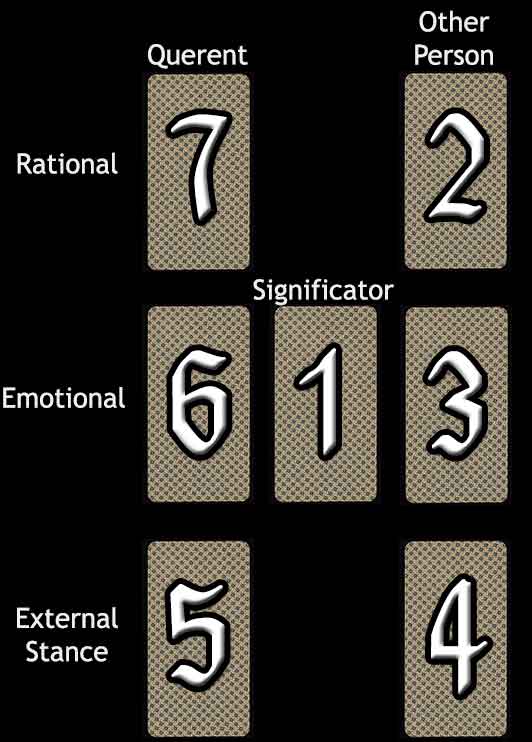
Difficulty: Easy
This tarot spread is easy to read, like a convenient chart. In this spread, court cards generally indicate actual people with the same characteristics. Knights (or corresponding princes, but not kings) and queens are meant to represent actual men and women in this tarot spread. Look for patterns in the cards as always.
Card #1 is the overall significator of the relationship. The two columns on either side of the significator characterise each individual's role in the relationship. The relationship does not have to be romantic. In fact, it could be a relationship between a person and a group, or even how two groups relate.
The top row, cards #7 & #2, is about the conscious thoughts of each person, or what they think about the relationship and likewise how they view their partner.
The middle row, cards #6 & #3, reveals the way each individual feels about the other. Emotional awareness corresponds to a person's unconscious thoughts that run deep, affecting a person in ways he or she is not fully aware of.
The bottom row, cards #5 & #4, represents the way each person behaves, in other words the stance taken regarding the relationship. The way a person acts may be genuine, but sometimes people are phony and manipulative, so it is best to weigh this card against the other person's cards to determine how they match up.
Your Relationship #1 Reading
| You | Other Person | ||
| Thought | 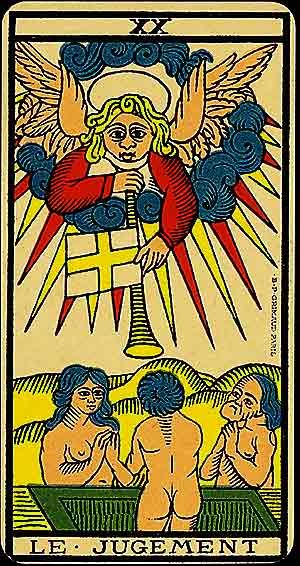 Judgement (Le Jugement) |
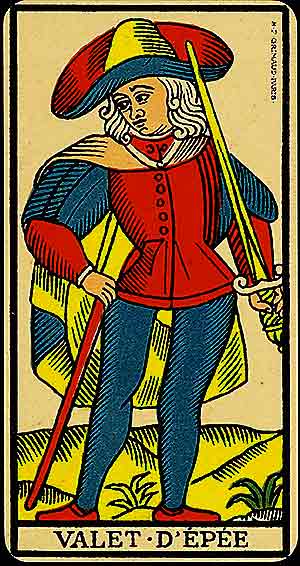 Valet of Swords |
|
| Emotion |  Four of Swords |
The Significator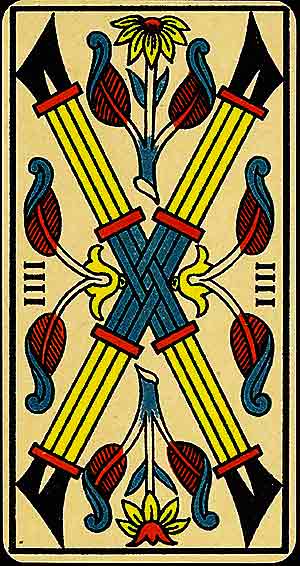 Four of Batons |
 Four of Cups |
| External Stance | 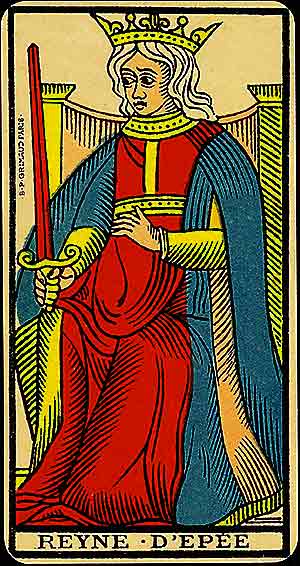 Queen of Swords |
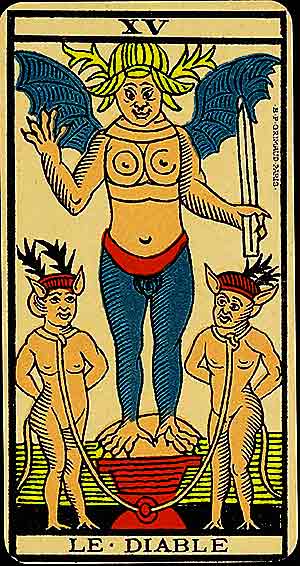 The Devil (Le Diable) |

The Significator
Four of Batons
Symbolism:
Four batons form a stable, rectangular frame adorned with budding leaves, signifying balance and structure. This card represents a foundation of support and a sense of accomplishment in one's endeavours.
Meaning:
The Four of Batons represents celebration, stability, and harmony. It marks a time to pause and appreciate achievements or milestones. This card often symbolises community, shared joy, and the fulfilment of goals.
In relationships, it indicates harmony, commitment, or joyful gatherings. Spiritually, it reflects alignment with your surroundings and a sense of belonging.
Keywords:
Celebration, harmony, stability, joy, milestones, unity, achievement, community, gratitude, fulfilment.

The Querent's Thoughts
Judgement
(Le Jugement)
Symbolism:
An angel blows a trumpet as figures rise from coffins below, symbolising resurrection and awakening. The praying hands of the figures reflect surrender and acceptance. The bright light of the angel signifies divine calling and revelation, while the mountains in the background represent challenges overcome.
Meaning:
Judgement represents awakening, self-assessment, and rebirth. It signals a time to evaluate your past and make amends, preparing for a new chapter. This card often appears when you are called to align with your higher purpose and embrace transformation.
In relationships, it suggests healing, forgiveness, or a new beginning. Spiritually, it encourages connection with your true calling.
Keywords:
Awakening, transformation, rebirth, judgement, self-assessment, forgiveness, redemption, clarity, divine calling, renewal.

The Other Person's Thoughts
Valet of Swords
Symbolism:
The Valet of Swords is shown standing confidently, holding a sword upright or at an angle, symbolising readiness and curiosity. The figure's alert posture reflects themes of observation, intellect, and the early stages of mastering mental or communicative skills.
Meaning:
The Valet of Swords symbolises intellectual curiosity, observation, and new ideas. It encourages exploring knowledge and being open to learning. However, it also warns of hasty communication or judgment.
In relationships, it suggests a need for honest dialogue or the exploration of new dynamics. Spiritually, it represents the first steps toward understanding profound truths.
Keywords:
Curiosity, observation, new ideas, communication, learning, honesty, vigilance, intellect, youthful energy, exploration.

The Querent's Emotions
Four of Swords
Symbolism:
Four swords are arranged symmetrically, often forming a square or cross-like pattern, symbolising rest and reflection. The imagery suggests a pause for recuperation, stability, and the need for introspection before moving forward.
Meaning:
The Four of Swords symbolises the need for rest, reflection, and recovery. It encourages taking time to recharge after challenges and to prepare for future endeavours. This card highlights the importance of mental clarity through stillness.
In relationships, it may indicate a pause or need for space. Spiritually, it represents retreating into contemplation to find peace.
Keywords:
Rest, recovery, introspection, stillness, clarity, pause, preparation, healing, reflection, mental rejuvenation.

The Other Person's Emotions
Four of Cups
Symbolism:
Four cups form a stable square, often surrounded by simpler decorative elements, representing introspection and emotional stability. The symmetry suggests contemplation or a period of emotional stagnation, urging reflection.
Meaning:
The Four of Cups represents introspection, apathy, or dissatisfaction. It suggests a need to re-evaluate your emotional state and consider opportunities you may be ignoring. This card warns against closing yourself off due to disillusionment or complacency.
In relationships, it reflects emotional distance or the need to reconnect. Spiritually, it calls for mindfulness and gratitude to rediscover meaning and purpose.
Keywords:
Introspection, apathy, discontent, emotional re-evaluation, opportunity, mindfulness, detachment, dissatisfaction, contemplation, stagnation.

The Querent's External Stance
Queen of Swords
Symbolism:
The Rayne of Swords is seated regally, holding a sword upright in one hand, often forward with an air of clarity and focus. The card symbolises wisdom, discernment, and the ability to make fair yet firm decisions based on logic and truth.
Meaning:
The Queen of Swords embodies intellect, honesty, and independence. She advises clear communication and setting boundaries. This card encourages blending compassion with logic, and facing situations with maturity and truth.
In relationships, it reflects fairness and emotional clarity. Spiritually, it represents wisdom gained through life's challenges.
Keywords:
Wisdom, clarity, independence, honesty, discernment, boundaries, intellect, maturity, truth, fairness.

The Other Person's External Stance
The Devil
(Le Diable)
Symbolism:
The Devil is portrayed as a horned figure with two chained human figures below, representing bondage to materialism or desires. The chains are loose, suggesting self-imposed limitations. Their animalistic features symbolise the materialism and polarity of nature.
Meaning:
The Devil represents temptation, materialism, and the shadow side of human nature. It highlights unhealthy attachments, addictions, or fears that may be holding you back. This card calls for awareness and the courage to break free from self-imposed limitations.
In relationships, it warns of codependency or power imbalances. Spiritually, the Devil challenges you to confront and integrate your shadow self.
Keywords:
Temptation, bondage, materialism, addiction, fear, control, power, shadow self, self-awareness, liberation.
